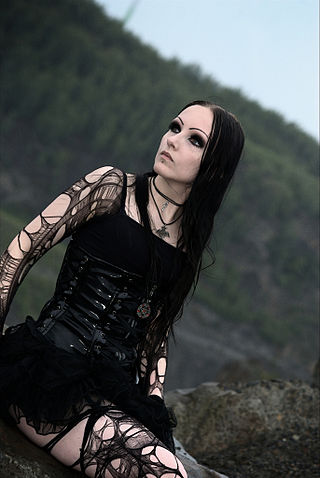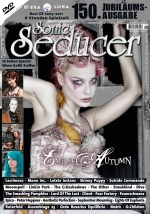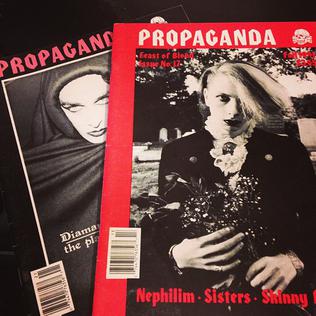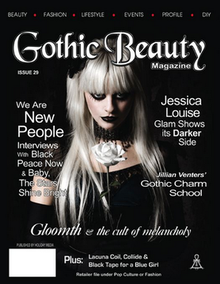
Goth is a music-based subculture that began in the United Kingdom during the early 1980s. It was developed by fans of gothic rock, an offshoot of the post-punk music genre. Post-punk artists who presaged the gothic rock genre and helped develop and shape the subculture include Siouxsie and the Banshees, Bauhaus, the Cure, and Joy Division.
Gothic rock is a style of rock music that emerged from post-punk in the United Kingdom in the late 1970s. The first post-punk bands which shifted toward dark music with gothic overtones include Siouxsie and the Banshees, Joy Division, Bauhaus, and the Cure.

Gothic fashion is a clothing style marked by dark, mysterious, antiquated, homogeneous, and often genderless features. It is worn by members of the goth subculture. Typical gothic fashion includes dyed black hair, exotic hairstyles, dark lipstick and dark clothing. Both male and female goths can wear dark eyeliner, dark nail polish and lipstick for a dramatic effect. Male goths use cosmetics at a higher rate than other men. Styles are often borrowed from the punk fashion and can also draw influence from Victorians and Elizabethan fashion. Goth fashion is sometimes confused with heavy metal fashion and emo fashion.
A rivethead or rivet head is a person associated with the industrial dance music scene. In stark contrast to the original industrial culture, whose performers and heterogeneous audience were sometimes referred to as "industrialists", the rivethead scene is a coherent youth culture closely linked to a discernible fashion style. The scene emerged in the late 1980s on the basis of electro-industrial, EBM, and industrial rock music. The associated dress style draws on military fashion and punk aesthetics with hints of fetish wear, mainly inspired by the scene's musical protagonists.

George Lawrence Petros is an American art designer, author, editor, interviewer and illustrator. From 1984 through 1992 he published and edited EXIT, a punk-inspired art and science fiction magazine he founded with Adam Parfrey and Kim Seltzer. From 1992 through 2000 he edited and art-directed Seconds, an all-interview music and culture magazine founded by Steven Blush. From 2000 through 2005 he was a contributing editor of Juxtapoz, the low-brow art magazine founded by Robert Williams, and the senior editor of Propaganda, a goth/industrial music and style magazine founded by Fred H. Berger. He is the author of Art That Kills: A Panoramic Portrait of Aesthetic Terrorism 1984-2001, The New Transsexuals: The Next Step In Human Evolution, and the editor of American Hardcore: A Tribal History.
The Batcave was a weekly club-night launched at 69 Dean Street in central London in 1982. It is considered to be the birthplace of the Southern English goth subculture. It lent its name to the term Batcaver, used to describe fans of the original gothic rock music, who would adorn themselves in Batwing coffin necklaces to distinguish themselves from other goth clubs.
Gothic metal is a fusion genre combining the aggression of heavy metal with the dark atmospheres of gothic rock. The music of gothic metal is diverse with bands known to adopt the gothic approach to different styles of heavy metal music. The genre originated during the early 1990s in the United Kingdom originally as an outgrowth of death-doom, a fusion of death metal and doom metal. Lyrics are generally dark and introspective with inspiration from gothic fiction as well as personal experiences.

Dark culture, also called dark alternative scene, includes goth and dark wave culture, the dark neoclassical/dark ambient scene, parts of the post-industrial scene parts of neofolk and the early gothic metal scene. Dark culture's origin lies in followers of dark wave and independent music, but over the decades it has developed to a social network held together by a common concept of aesthetics, self-representation, and individualism. The musical preferences of the dark scene are characterized by a mix of styles ranging from futurism, electropop, early music, (neo-) classical, and folk music to punk rock, rock, techno and ambient music.
Alternative fashion or alt fashion is fashion that stands apart from mainstream, commercial fashion. It includes both styles which do not conform to the mainstream fashion of their time and the styles of specific subcultures. Some alternative fashion styles are attention-grabbing and more artistic than practical, while some develop from anti-fashion sentiments that focus on simplicity and utilitarianism.
The Toronto goth scene, the cultural locus of the goth subculture in Toronto, Ontario, Canada and the associated music and fashion scene, has distinct origins from goth scenes of other goth subcultural centres, such as the UK or Germany. Originally known as the "Batcavers", the term "goth" appeared only after 1988, when it was applied to the pre-existent subculture. Distinctive features included internationally recognized gothic and vampiric fashion store 'Siren', a goth-industrial bar named 'Sanctuary: The Vampire Sex Bar', and Forever Knight, a television series about an 800-year-old vampire living in Toronto. In Toronto, the goths did not seek to reject mainstream status, and achieved partial acceptance throughout the mid to late 1990s.
Bats Day in the Fun Park, also known as Bats Day, Goth Day, Goth Day at Disneyland, The Spooky Trip to Disneyland Resort, CA., Bats Day in the Park and Bats Day Out, started in August 1999 as a joint effort between the promoters of the goth, industrial, and deathrock clubs Absynthe and Release the Bats. It has become an annual three-day event taking place in Anaheim, CA, United States near Disneyland. In previous years, the events commenced on the weekend before Labor Day. Since about 2008, Bats Day event weekends have usually happened on the first or third weekend in May.
Rose Mortem is an American fashion designer, musician, model, and entrepreneur. Rose is most widely known for her dark romantic fashion stylings and as a member of the Gothic rock band The Awakening. She is a graduate of Harvard University.
Natasha Scharf is an author, disc jockey, presenter and journalist best known for her work publicising gothic, rock, metal and progressive metal music and subcultures. Since 2019, she has been the Deputy Editor of Prog.

Sonic Seducer is a German music magazine that covers gothic rock, new wave, EBM and other kinds of electronic music and culture. The magazine is noted for organizing the annual M'era Luna Festival. Since its inception in 1994, the Sonic Seducer has become one of the major publications of the dark culture in Germany.
World Goth Day is observed annually on 22 May. The Official World Goth Day site defines it as "a day where the goth scene gets to celebrate its own being, and an opportunity to make its presence known to the rest of the world."

Propaganda was an American gothic subculture magazine. It was founded in 1982 by Fred H. Berger, a photographer from New York City. Berger's photography was featured prominently in the magazine. Propaganda focused on all aspects of the goth culture, including fashion, sexuality, music, art and literature. Propaganda was, at the time of its final issue in 2002, the longest running and most popular gothic subculture magazine in the United States.

Wednesday Mourning is an American actress and model. She specializes in the Goth subculture and has been influential in goth fashion, as well as being the celebrity spokesmodel for Atelier Gothique and appearing as a model for the band My Chemical Romance's CD Welcome To The Black Parade. She was awarded 2010 Goth Day Model of the year and LA Weekly’s Goth Girl of the Week, and since 2012, Mourning has been a co-star on Oddities: San Francisco, a Science Channel program. Mourning is also curator of an esoteric bookstore, Orphic Vellum Books, the only one of its kind in the U.S. She has appeared in several publications including Gothic Beauty and Elle Magazine and is a writing contributor for Celtic Family Magazine.

Gothic Western is a subculture, artistically similar to gothic Americana, but blends goth and Western lifestyles that are notably visible in fashion, music, film and literature.

Mall goths are a subculture that began in the late-1990s in the United States. Originating as a pejorative to describe people who dressed goth for the fashion rather than culture, it eventually developed its own culture based around nu metal, industrial metal, emo and the Hot Topic store chain. It has variously been described as a part of the goth subculture, as well as a separate subculture simply influenced by goth.









